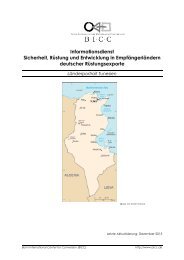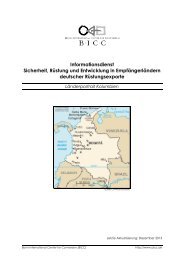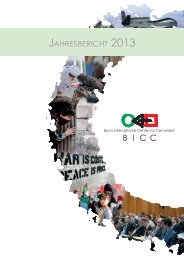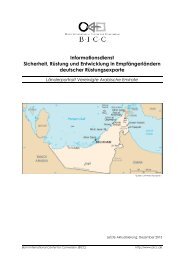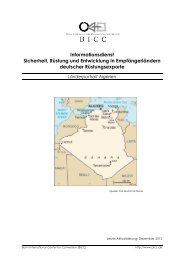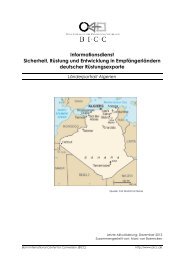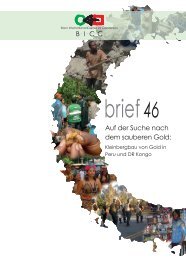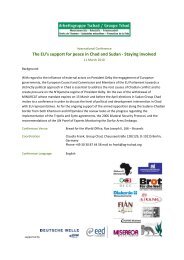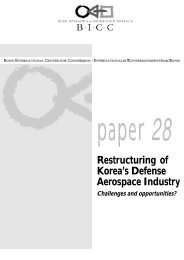English - BICC
English - BICC
English - BICC
You also want an ePaper? Increase the reach of your titles
YUMPU automatically turns print PDFs into web optimized ePapers that Google loves.
Proliferation of<br />
Violence and<br />
the Momentum<br />
of Arms<br />
The start of decommissioning in<br />
October 2001 has not yet helped<br />
to halt the proliferation of violence<br />
that has burdened the Northern Irish<br />
peace process over the last eighteen<br />
months. Deriving a connection<br />
between decommissioning and the<br />
level of paramilitary violence may seem<br />
odd at first glance, however, a closer<br />
examination reveals a distinct<br />
correlation between the two. The<br />
object or purpose of decommissioning<br />
is not limited to the physical removal<br />
of paramilitary arms from Northern<br />
Ireland; it also aims to obliterate the<br />
culture of violence that engulfs this<br />
divided, war-torn society.<br />
In the following passage Darby and<br />
Mac Ginty provide a superb analysis of<br />
the omnipresent threat that violence<br />
poses to peace processes:<br />
“The most obvious threat to any peace process<br />
is that violence may start up again. Indeed it<br />
seems likely that a combination of factors<br />
would make its return inevitable: an<br />
entrenched culture of violence; the continuing<br />
presence of arms; failure to move towards<br />
successful negotiations and compromise; and<br />
unwillingness to remove the security apparatus<br />
erected during the period of violence. The key<br />
question then is the resilience of the peace<br />
process itself, and its ability to continue,<br />
despite a resumption of violence …”(Darby<br />
and Mac Ginty, 2000, pp.12–13).<br />
Like most societies emerging from a<br />
protracted, violent conflict, Northern<br />
Ireland has faced a continuation, and at<br />
times a proliferation, of violence after<br />
the declaration or resumption of ceasefires—in<br />
1994 and 1997—and even<br />
after the settlement of the peace<br />
accord of 1998. As the interests and<br />
priorities of the conflicting parties in<br />
the peace process changed, diffused,<br />
and fragmented, the nature of violence<br />
altered accordingly. The form of<br />
violence that has evolved in the<br />
province has proved to be more<br />
difficult to tackle than the mainly<br />
politically motivated violence that<br />
prevailed prior to the Agreement.<br />
Top level political debate and crisis<br />
management regarding the<br />
implementation of the Good Friday<br />
Agreement seemingly left little room to<br />
address these new problems in an<br />
adequate manner. Somewhere along<br />
the road from the Agreement’s<br />
negotiation to the beginning of its<br />
implementation phase, the distinction<br />
between the overarching commitment<br />
to non-violent means outlined in the<br />
Mitchell principles (see Box A), and the<br />
method of handling the decommissioning<br />
issue in a broad cross-sectarian<br />
context of confronting violence, was<br />
blurred.<br />
One of the significant findings of this<br />
study is that the arduous<br />
decommissioning debate rarely touched<br />
on the problems that have emerged as<br />
a result of the gradual metamorphosis<br />
of violence since the signing of the<br />
Agreement. The proliferation of<br />
violence did not become a major public<br />
argument in favour of an<br />
intensification of decommissioning.<br />
Demands for decommissioning were<br />
rarely expressed as a means to halt the<br />
escalating violence. A wall of paradoxes<br />
seemed to separate the two<br />
debates. The availability of arms, an<br />
evident linkage that has been<br />
acknowledged as a factor that created<br />
its own momentum in the vicious circle<br />
of violence by virtually every interview<br />
partner on both sides of the political<br />
B·I·C·C<br />
cultures and markets of<br />
violence<br />
spectrum, was apparently perceived to<br />
be less relevant than other factors. We<br />
will attempt to peer behind this<br />
paradoxical wall to analyse why there<br />
has been such difficulties in dealing<br />
with post-Agreement violence,<br />
particularly in relation to the issue of<br />
decommissioning.<br />
Diversification of<br />
inter-, and intrasectarian<br />
violence<br />
John Darby identifies a diverse array of<br />
types and patterns of violence that<br />
pose a threat to the transformation<br />
period of a conflict:<br />
the changing role of state violence;<br />
paramilitary violence with a possible<br />
return to politically motivated<br />
violence, the use of “tactical”<br />
violence, the spoiler dilemma of<br />
zealots versus dealers, and intraparamilitary<br />
forms of “family<br />
feuding”;<br />
violence in the community with<br />
ethnic rivals returning to the streets,<br />
resulting in a rise in “ordinary<br />
decent crime”;<br />
the emergence of new security<br />
related issues in negotiations<br />
(Darby, 2000).<br />
A combination of the second, third,<br />
and, to a certain degree, the last type<br />
of violence appears to be relevant in<br />
the case of Northern Ireland,<br />
particularly in the post-Agreement<br />
period.<br />
The outbreak, late in the summer of<br />
2000, of a violent intra-Loyalist feud<br />
between the two major paramilitary<br />
groups, the UDA/UFF and the UVF,<br />
over territorial claims in Belfast’s<br />
Shankill area caused the deaths of at<br />
least seven people and led to the<br />
expulsion of more than 70 families. In<br />
spring 2001, the Loyalist “family feud”<br />
spilled over the sectarian divide in the<br />
form of threats and attacks on<br />
Catholic homes in Belfast, the most<br />
63



